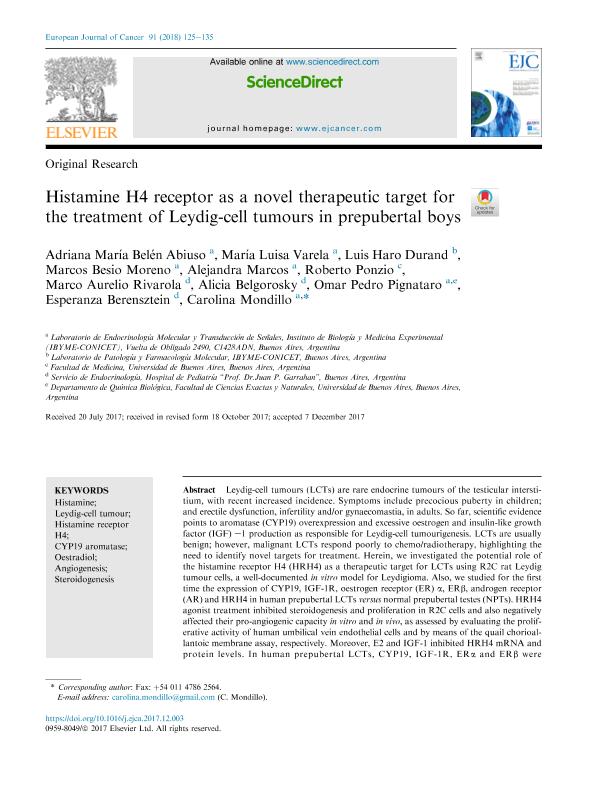Artículo
Histamine H4 receptor as a novel therapeutic target for the treatment of Leydig-cell tumours in prepubertal boys
Abiuso, Adriana María Belén ; Varela, María Luisa
; Varela, María Luisa ; Haro Durand, Luis Alberto
; Haro Durand, Luis Alberto ; Besio Moreno, Marcos Alberto
; Besio Moreno, Marcos Alberto ; Marcos, Alejandra Lucía
; Marcos, Alejandra Lucía ; Ponzio, Roberto; Rivarola, Marco Aurelio
; Ponzio, Roberto; Rivarola, Marco Aurelio ; Belgorosky, Alicia
; Belgorosky, Alicia ; Pignataro, Omar Pedro
; Pignataro, Omar Pedro ; Berensztein, Esperanza Beatriz; Mondillo, Carolina
; Berensztein, Esperanza Beatriz; Mondillo, Carolina
 ; Varela, María Luisa
; Varela, María Luisa ; Haro Durand, Luis Alberto
; Haro Durand, Luis Alberto ; Besio Moreno, Marcos Alberto
; Besio Moreno, Marcos Alberto ; Marcos, Alejandra Lucía
; Marcos, Alejandra Lucía ; Ponzio, Roberto; Rivarola, Marco Aurelio
; Ponzio, Roberto; Rivarola, Marco Aurelio ; Belgorosky, Alicia
; Belgorosky, Alicia ; Pignataro, Omar Pedro
; Pignataro, Omar Pedro ; Berensztein, Esperanza Beatriz; Mondillo, Carolina
; Berensztein, Esperanza Beatriz; Mondillo, Carolina
Fecha de publicación:
03/2018
Editorial:
Elsevier
Revista:
European Journal of Cancer
ISSN:
0959-8049
Idioma:
Inglés
Tipo de recurso:
Artículo publicado
Clasificación temática:
Resumen
Leydig-cell tumours (LCTs) are rare endocrine tumours of the testicular interstitium, with recent increased incidence. Symptoms include precocious puberty in children; and erectile dysfunction, infertility and/or gynaecomastia, in adults. So far, scientific evidence points to aromatase (CYP19) overexpression and excessive oestrogen and insulin-like growth factor (IGF) –1 production as responsible for Leydig-cell tumourigenesis. LCTs are usually benign; however, malignant LCTs respond poorly to chemo/radiotherapy, highlighting the need to identify novel targets for treatment. Herein, we investigated the potential role of the histamine receptor H4 (HRH4) as a therapeutic target for LCTs using R2C rat Leydig tumour cells, a well-documented in vitro model for Leydigioma. Also, we studied for the first time the expression of CYP19, IGF-1R, oestrogen receptor (ER) α, ERβ, androgen receptor (AR) and HRH4 in human prepubertal LCTs versus normal prepubertal testes (NPTs). HRH4 agonist treatment inhibited steroidogenesis and proliferation in R2C cells and also negatively affected their pro-angiogenic capacity in vitro and in vivo, as assessed by evaluating the proliferative activity of human umbilical vein endothelial cells and by means of the quail chorioallantoic membrane assay, respectively. Moreover, E2 and IGF-1 inhibited HRH4 mRNA and protein levels. In human prepubertal LCTs, CYP19, IGF-1R, ERα and ERβ were overexpressed compared with NPTs. In contrast, HRH4 staining was weak in LCTs, but moderate/strong and confined to the interstitium in NPTs. Importantly, HRH4 was absent or barely detectable in seminiferous tubules or germ cells. Overall, our results point to HRH4 as a novel therapeutic target in LCTs.
Archivos asociados
Licencia
Identificadores
Colecciones
Articulos(IBYME)
Articulos de INST.DE BIOLOGIA Y MEDICINA EXPERIMENTAL (I)
Articulos de INST.DE BIOLOGIA Y MEDICINA EXPERIMENTAL (I)
Articulos(IQUIFIB)
Articulos de INST.DE QUIMICA Y FISICO-QUIMICA BIOLOGICAS "PROF. ALEJANDRO C. PALADINI"
Articulos de INST.DE QUIMICA Y FISICO-QUIMICA BIOLOGICAS "PROF. ALEJANDRO C. PALADINI"
Articulos(SEDE CENTRAL)
Articulos de SEDE CENTRAL
Articulos de SEDE CENTRAL
Citación
Abiuso, Adriana María Belén; Varela, María Luisa; Haro Durand, Luis Alberto; Besio Moreno, Marcos Alberto; Marcos, Alejandra Lucía; et al.; Histamine H4 receptor as a novel therapeutic target for the treatment of Leydig-cell tumours in prepubertal boys; Elsevier; European Journal of Cancer; 91; 3-2018; 125-135
Compartir
Altmétricas



